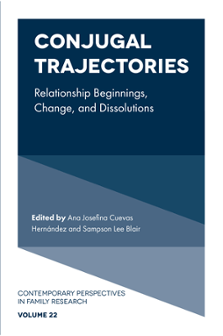
Index
Conjugal Trajectories: Relationship Beginnings, Change, and Dissolutions
ISBN: 978-1-80455-395-4, eISBN: 978-1-80455-394-7
ISSN: 1530-3535
Publication date: 15 May 2023
Citation
(2023), "Index", Hernández, A.J.C. and Blair, S.L. (Ed.) Conjugal Trajectories: Relationship Beginnings, Change, and Dissolutions (Contemporary Perspectives in Family Research, Vol. 22), Emerald Publishing Limited, Leeds, pp. 255-263. https://doi.org/10.1108/S1530-353520230000022013
Publisher
:Emerald Publishing Limited
Copyright © 2023 Ana Josefina Cuevas Hernández and Sampson Lee Blair
INDEX
Note: Page numbers followed by “n” indicate notes.
- Prelims
- Chapter 1: An Exploratory Study of the Influence of Marital Attitudes and Skin Tone Perception on the Romantic Relationship Quality Among African American and Latinx Young Adults
- Chapter 2: Breaking Up Is Hard to Do: Investigating Breakup Distress and Sexual Regret in Undergraduates' Casual and Committed Sexual Relationships
- Chapter 3: Romantic, Confessional and Post-Romantic: The Timeline of Conjugality at a Distance Between Mexico and the United States
- Chapter 4: Age-Homogamy and Age-Heterogamy in Three Generations of Heterosexual Women and Men in Mexico
- Chapter 5: Predictors of Marital Quality: What Makes a Happy Marriage in Croatia?
- Chapter 6: Marriage Formation in Vietnam: Characteristics and Changes
- Chapter 7: Education, Marriage Cohorts, and Different Pathways to Marriage in East Asian Societies
- Chapter 8: Life Trajectories and Reproductive Strategies of Costa Rican Households: An Intergenerational Perspective
- Chapter 9: What Difference Does Marriage Make? Life Course Trajectories and the Transition to Marriage for Gay Men and Lesbians
- Chapter 10: Identifying Predictors of First Versus Subsequent Divorce Among Divorcing Parents
- Chapter 11: Unintended Higher-Order Births and Union Stability: Variation by Union Characteristics
- Chapter 12: Dynamism and Changes in the Abia Family Structure and Conjugal Relationship: The Influence of the Nigerian Civil War
- Index